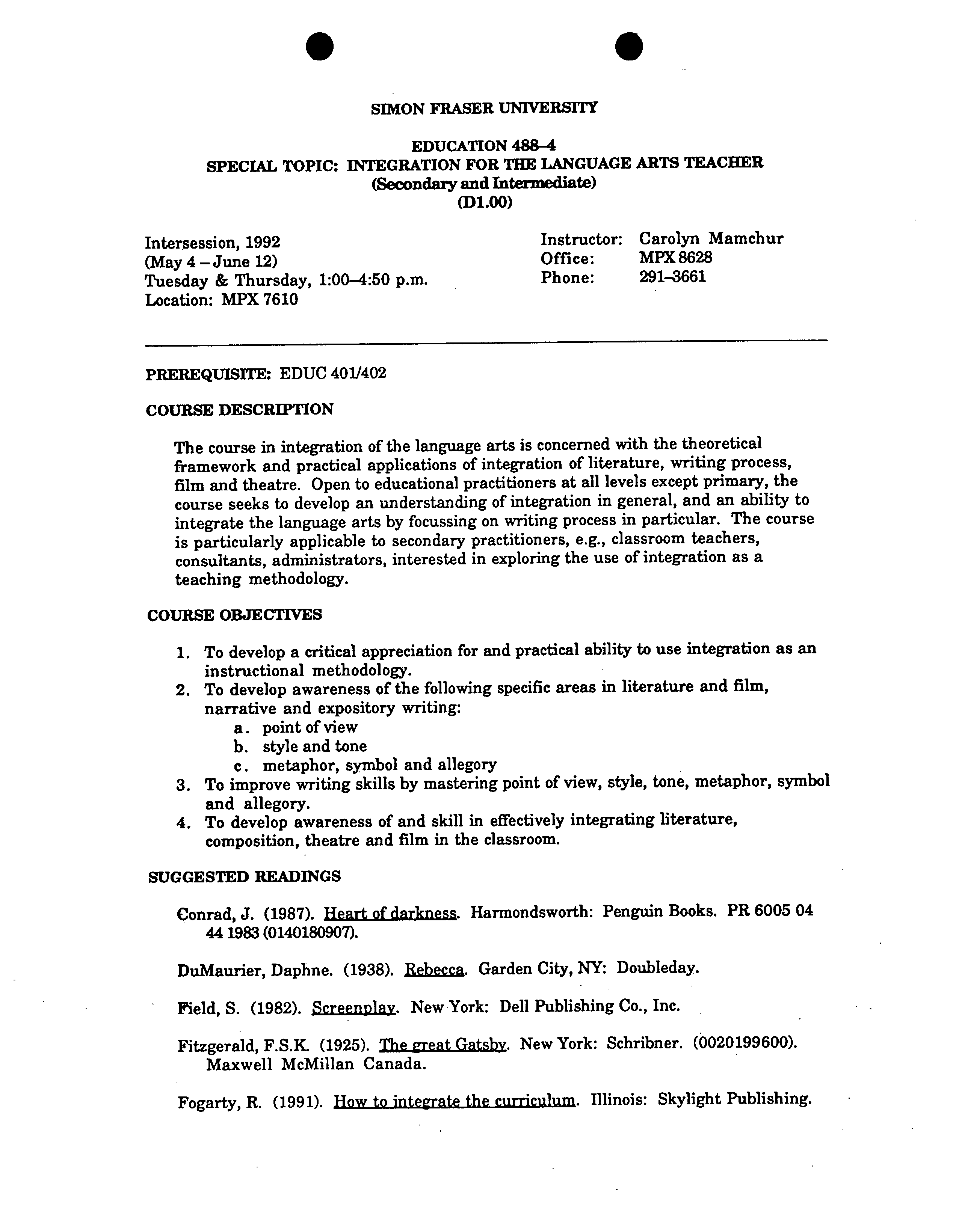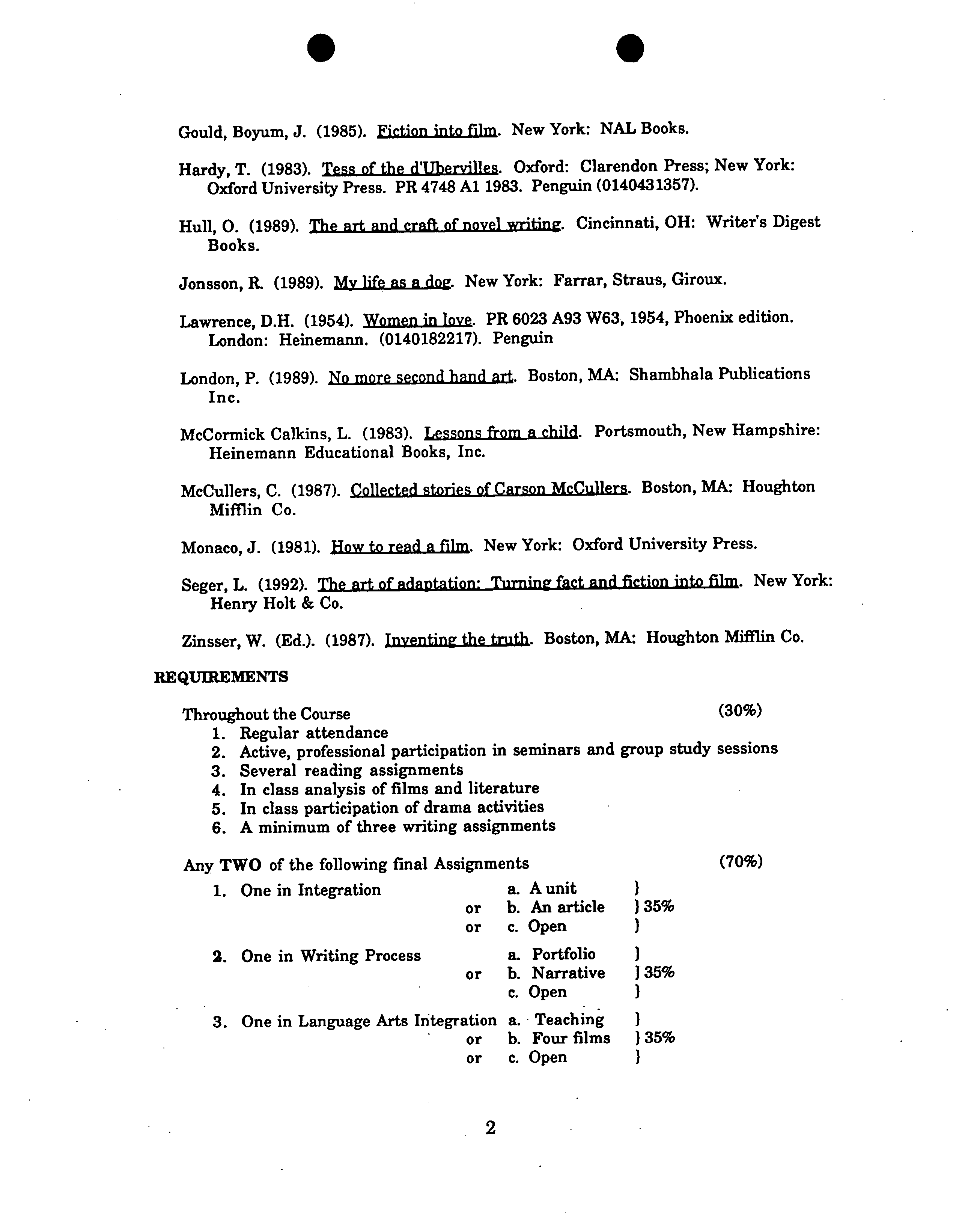S
S
SIMON FRASER UNIVERSITY
EDUCATION 488-4
SPECIAL TOPIC: INTEGRATION FOR THE LANGUAGE ARTS TEACHER
(Secondary and Intermediate)
(D1.0O)
Intersession, 1992
Instructor: Carolyn Mamchur
(May 4—June 12)
Office:
MPX 8628
Tuesday & Thursday, 1:00-4:50 p.m.
Phone:
291-3661
Location: MPX 7610
PREREQUISITE:
EDUC 401i402
COURSE DESCRIPTION
The course in integration of the language arts is concerned with the theoretical
framework and practical applications of integration of literature, writing process,
film and theatre. Open to educational practitioners at all levels except primary, the
course seeks to develop an understanding of integration in general, and an ability to
integrate the language arts by focussing on writing process in particular. The course
is particularly applicable to secondary practitioners, e.g., classroom teachers,
consultants, administrators, interested in exploring the use of integration as a
teaching methodology.
COURSE OBJECTIVES
1. To develop a critical appreciation for and practical ability to use integration as an
instructional methodology.
2. To develop awareness of the following specific areas in literature and film,
narrative and expository writing:
a.
point of view
b.
style and tone
c.
metaphor, symbol and allegory
3. To improve writing skills by mastering point of view, style, tone, metaphor, symbol
and allegory.
4. To develop awareness of and skill in effectively integrating literature,
composition, theatre and film in the classroom.
SUGGESTED READINGS
Conrad, J. (1987). Heart of darkness. Harmondsworth: Penguin Books. PR 6005 04
44
1983 (0140180907).
DuMaurier, Daphne. (1938). Rebecca. Garden City, NY: Doubleday.
Field, S. (1982). Screenolav. New York: Dell Publishing Co., Inc.
Fitzgerald,
F.S.K.
(1925). The great Gatsby. New York: Schribner. (0020199600).
Maxwell McMillan Canada.
Fogarty, R. (1991). How to inte
g
rate the curriculum. Illinois: Skylight Publishing.
.
.
Gould, Boyum, J. (1985). Fiction into film.
New York: NAL Books.
Hardy, T. (1983). Tess of the d'Ubervilles.
Oxford: Clarendon Press; New York:
Oxford University Press. PR 4748 Al
1983. Penguin (0140431357).
Hull, 0. (1989). The art and craft of novel
writing. Cincinnati, OH: Writer's Digest
Books.
Jonsson, R. (1989). My life as a dog. New York: Farrar, Straus, Giroux.
Lawrence, D.H. (1954). Women in love.
PR 6023 A93 W63, 1954, Phoenix edition.
London: Heinemann. (0140182217).
Penguin
London, P. (1989). No more second hand
art. Boston, MA: Shambhala Publications
Inc.
McCormick Calkins, L. (1983). Lessons
from a child. Portsmouth, New Hampshire:
Heinemann Educational Books, Inc.
McCullers, C. (1987). Collected stories of
Carson McCullers. Boston, MA: Houghton
Muffin Co.
Monaco, J. (1981). How to read a film.
New York: Oxford University Press.
Seger, L. (1992). The art of adaptation:
Turning fact and fiction into film. New York:
Henry Holt & Co.
Zinsser, W. (Ed.). (1987). Inventing the
truth. Boston, MA: Houghton Mifflin Co.
REQUIREMENTS
Throughout the Course
(30%)
1.
Regular attendance
2.
Active, professional participation in seminars and group study sessions
3.
Several reading assignments
4.
In class analysis of films and literature
5.
In class participation of drama activities
6.
A minimum of three writing assignments
Any TWO of the following final Assignments
(70%)
1.
One in Integration
a.
A unit
)
or
b.
An article
) 35%
or
c.
Open
)
2.
One in Writing Process
a.
Portfolio
)
or
b.
Narrative
135%
c.
Open
I
3.
One in Language Arts Integration
a.
Teaching
I
or
b.
Four films
) 35%
or
c.
Open
Back to top


